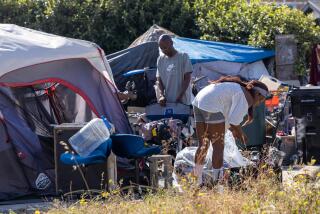Editorial: Want to lower the number who are homeless? Prevent people from falling into homelessness

- Share via
It will come as no surprise to anyone living in Los Angeles that the number of homeless people is staggeringly high. What might be surprising is the almost equally large number of homeless people who are successfully moved off the streets in the county of Los Angeles. According to the Los Angeles Homeless Services Authority, more than 20,000 homeless people were housed in 2020, and more than 64,000 were housed over the last three years. Yet that is close to the number of homeless people tallied in Los Angeles County in the annual homeless count in January of last year — 66,436. (Due to concerns about COVID, the count, which relies on thousands of volunteers, was not held this year.)
The grim fact is that more people fall into homelessness each day than the county can permanently house. Based on 2019 statistics from the Homeless Services Authority, 207 people make it out of homelessness each day. They get help from an agency or service provider or they manage on their own to resolve their problems and find housing. But a total of 227 people become homeless each day.
For the last several years, the steady stream of newly homeless people has been an economic inevitability in a county with a severe shortage of affordable housing and where wages have not risen enough to cover escalating rents.
The city and county invest a huge amount of money and effort into sheltering, housing and providing services to homeless people. And that should not stop; we need more permanent housing, and we need it faster. But the city and the county are not investing enough in prevention measures to keep people from falling into homelessness in the first place. And if that doesn’t change, we will never staunch the flow of people with a precarious grip on housing into the throes of homelessness.
The city and county already have numerous prevention programs across various agencies for very low-income residents. They offer rental assistance to help settle rent debts and cover future payments. They also offer legal assistance for very low-income tenants facing eviction. But these programs don’t begin to fill the need.
The Homeless Services Authority gets $23 million a year for prevention work from the county through Measure H funds — the voter-approved sales tax measure that generates several hundred million dollars a year for homelessness services. LAHSA officials say they prevented 5,500 people from becoming homeless in 2020. But the agency can’t prevent everyone from becoming homeless at the same time that its hands are more than full trying to shelter and house already homeless people.
Prevention programs need to be scaled up across L.A. County. That means providing extensive rental assistance and legal help to tenants facing eviction. And the city of Los Angeles does, in fact, plan to increase its rental subsidies.
That’s good, but city and county officials need to make sure they are finding people in danger of becoming homeless. These programs need to be targeted to the people most at risk, which includes very low-income individuals and families, young people aging out of the foster care system and people leaving jail with nothing. And the people most at risk need to be able to find the programs and obtain help fast.
The county’s chief executive officer submitted a plan last May to the Board of Supervisors to improve the county’s homelessness prevention efforts. One piece is an assessment tool developed by researchers at UCLA and the University of Chicago that identifies people who are most at risk for becoming homeless, including vulnerable people served through the healthcare and jail systems.
This year, the county started funding the use of this assessment tool in a pilot program being run by the Department of Health Services. The program will focus on the clients at greatest risk of becoming homeless. So the results have yet to be seen. If it works, it could be used in other departments and increase the county’s ability to find people on the verge of homelessness.
Although these programs offer a promising start, the county won’t know how effective they are until a new homeless count reveals how many people are still falling into homelessness. Unlike the process of building housing for homeless people, the process of keeping people in their housing cannot take years to bear fruit. In Los Angeles, the ranks of the newly homeless are swelling by the day.
More to Read
A cure for the common opinion
Get thought-provoking perspectives with our weekly newsletter.
You may occasionally receive promotional content from the Los Angeles Times.










